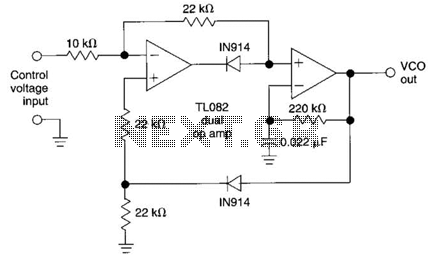
Carrier-Current Baby-Alert Transmitter Circuit

The baby-alert transmitter is constructed using an LM324 quad operational amplifier (U1), two LMC555CM CMOS oscillator/timers (U2 and U3), along with several supporting components. The transmitter activates upon detecting sound at MIC1, emitting a signal. Its operational frequency is approximately 125 kHz, suitable for triggering an alarm receiver.
The baby-alert transmitter circuit utilizes the LM324 quad op-amp as the primary processing unit, which provides the necessary amplification and signal conditioning. The circuit is designed to monitor ambient sound levels through a microphone (MIC1). When sound is detected, the op-amp amplifies the audio signal, which is then used to trigger the two LMC555CM timers.
The LMC555CM timers are configured in astable mode to generate a continuous square wave signal at a frequency of approximately 125 kHz. This frequency is chosen to ensure effective transmission and minimal interference with other devices. The output from the timers can be connected to an RF transmitter or directly to an alarm receiver, depending on the application requirements.
Supporting components in the circuit include resistors and capacitors that set the gain of the op-amp and determine the timing characteristics of the 555 timers. Proper selection of these components is essential to ensure reliable operation and optimal performance of the transmitter.
Overall, this baby-alert transmitter circuit serves as an efficient solution for monitoring sound levels in environments such as nurseries, providing a means to alert caregivers when a baby is in distress or making noise. The combination of the LM324 op-amp and LMC555CM timers allows for a compact and effective design that can be integrated into various alarm systems. The baby-alert transmitter is built around an LM324 quad op amp (Ul), two LMC555CM CMOS oscillator/timers (U2 and U3), and a few support components. The transmitter sends a signal on receipt of a sound at MIC1. It has a frequency of around 125 kHz and can be used to trigger an alarm receiver.
The baby-alert transmitter circuit utilizes the LM324 quad op-amp as the primary processing unit, which provides the necessary amplification and signal conditioning. The circuit is designed to monitor ambient sound levels through a microphone (MIC1). When sound is detected, the op-amp amplifies the audio signal, which is then used to trigger the two LMC555CM timers.
The LMC555CM timers are configured in astable mode to generate a continuous square wave signal at a frequency of approximately 125 kHz. This frequency is chosen to ensure effective transmission and minimal interference with other devices. The output from the timers can be connected to an RF transmitter or directly to an alarm receiver, depending on the application requirements.
Supporting components in the circuit include resistors and capacitors that set the gain of the op-amp and determine the timing characteristics of the 555 timers. Proper selection of these components is essential to ensure reliable operation and optimal performance of the transmitter.
Overall, this baby-alert transmitter circuit serves as an efficient solution for monitoring sound levels in environments such as nurseries, providing a means to alert caregivers when a baby is in distress or making noise. The combination of the LM324 op-amp and LMC555CM timers allows for a compact and effective design that can be integrated into various alarm systems. The baby-alert transmitter is built around an LM324 quad op amp (Ul), two LMC555CM CMOS oscillator/timers (U2 and U3), and a few support components. The transmitter sends a signal on receipt of a sound at MIC1. It has a frequency of around 125 kHz and can be used to trigger an alarm receiver.





